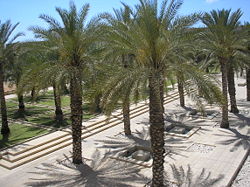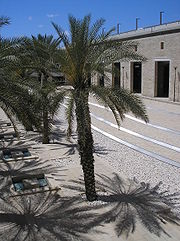
Central Garden at Ben-Gurion International Airport
Encyclopedia
The Ben-Gurion International Airport Garden is a garden outside Terminal 3 of Ben-Gurion International Airport on the outskirts of Tel Aviv
, Israel
, designed by the architecture firm of Shlomo Aronson
.
, the garage was split in two structures in order to provide a space for the Central Garden. Because of its location, the garden is meant to be experienced from “particular elevated vantage points as a portrait” rather than by movement though it. The placement of the garden also provides a view out to the surrounding landscape as opposed to a view of the facade of the parking structure. The garden is meant to provide an abstract interpretation of the regional landscape from ocean to mountains.

 The overall concept was for the design, which includes a larger 65 acres (26.3 ha) site that includes a road and an interchange in addition to the 5 acres (2 ha) Central Garden, was for it to relate strongly to the surrounding landscape. Plants common to the area were selected based on their regional presence. The gradual elevation change (approximately 15 feet (4.6 m)) within the garden is meant to symbolize the ascent from Tel Aviv
The overall concept was for the design, which includes a larger 65 acres (26.3 ha) site that includes a road and an interchange in addition to the 5 acres (2 ha) Central Garden, was for it to relate strongly to the surrounding landscape. Plants common to the area were selected based on their regional presence. The gradual elevation change (approximately 15 feet (4.6 m)) within the garden is meant to symbolize the ascent from Tel Aviv
to Jerusalem while also accommodating the practical requirement of the connecting various elevations of the parking garages with adjacent roads. Aronson symbolizes the Mediterranean coastline through the formal arrangement of materials like stone (a local limestone) and stainless steel. Gravel is used to represent the beaches of the western border of Israel
, and a grid of palm trees recalls the seaside promenades that are growing in popularity within Israel
. The grid arrangement also references the agricultural plantings of palm trees in the region. With the shift in elevation through the site comes a change from paved surface to planted areas of wheat fields, grasses, and orange groves. Small channels of water run through the garden, using a traditional technique for areas prone to rapid evaporation and indicating the need for human intervention in hydrating the arid landscape. The uppermost terrace contains a grove of olive trees, a tree common to the Judean Mountains
around Jerusalem and the highest elevations within the country. Shlomo Aronson
and project architect Barbara Aronson intended for the garden to be an abstraction of the region that allows visitors to gain a “deeper feeling of place” regardless of religious or political affiliations.
in 2005.
Tel Aviv
Tel Aviv , officially Tel Aviv-Yafo , is the second most populous city in Israel, with a population of 404,400 on a land area of . The city is located on the Israeli Mediterranean coastline in west-central Israel. It is the largest and most populous city in the metropolitan area of Gush Dan, with...
, Israel
Israel
The State of Israel is a parliamentary republic located in the Middle East, along the eastern shore of the Mediterranean Sea...
, designed by the architecture firm of Shlomo Aronson
Shlomo Aronson
Shlomo Aronson is an Israeli landscape architect. His works range from master plans for reforestation, archaeological parks and freeway planting schemes to urban plazas.-Biography:...
.
History
Originally, the design of the airport included one parking garage but at the suggestion of local lead architect Ram KarmiRam Karmi
Ram Karmi is a leading Israeli architect. He is head of the Tel Aviv-based Ram Karmi Architects company, and is known for his Brutalist style.-Biography:Ram Karmi was born in Jerusalem, and grew up in Tel Aviv...
, the garage was split in two structures in order to provide a space for the Central Garden. Because of its location, the garden is meant to be experienced from “particular elevated vantage points as a portrait” rather than by movement though it. The placement of the garden also provides a view out to the surrounding landscape as opposed to a view of the facade of the parking structure. The garden is meant to provide an abstract interpretation of the regional landscape from ocean to mountains.
Layout


Tel Aviv
Tel Aviv , officially Tel Aviv-Yafo , is the second most populous city in Israel, with a population of 404,400 on a land area of . The city is located on the Israeli Mediterranean coastline in west-central Israel. It is the largest and most populous city in the metropolitan area of Gush Dan, with...
to Jerusalem while also accommodating the practical requirement of the connecting various elevations of the parking garages with adjacent roads. Aronson symbolizes the Mediterranean coastline through the formal arrangement of materials like stone (a local limestone) and stainless steel. Gravel is used to represent the beaches of the western border of Israel
Israel
The State of Israel is a parliamentary republic located in the Middle East, along the eastern shore of the Mediterranean Sea...
, and a grid of palm trees recalls the seaside promenades that are growing in popularity within Israel
Israel
The State of Israel is a parliamentary republic located in the Middle East, along the eastern shore of the Mediterranean Sea...
. The grid arrangement also references the agricultural plantings of palm trees in the region. With the shift in elevation through the site comes a change from paved surface to planted areas of wheat fields, grasses, and orange groves. Small channels of water run through the garden, using a traditional technique for areas prone to rapid evaporation and indicating the need for human intervention in hydrating the arid landscape. The uppermost terrace contains a grove of olive trees, a tree common to the Judean Mountains
Judean Mountains
The Judaean Mountains, ;, also Judaean Hills and Hebron Hills is a mountain range in Israel and the West Bank where Jerusalem and several other biblical cities are located. The mountains reach a height of 1,000 m.-Geography:...
around Jerusalem and the highest elevations within the country. Shlomo Aronson
Shlomo Aronson
Shlomo Aronson is an Israeli landscape architect. His works range from master plans for reforestation, archaeological parks and freeway planting schemes to urban plazas.-Biography:...
and project architect Barbara Aronson intended for the garden to be an abstraction of the region that allows visitors to gain a “deeper feeling of place” regardless of religious or political affiliations.
Symbolism
Aronson says the Central Garden was designed as a "connective experience" that links up with the agrarian landscape along the route to Jerusalem, with its citrus orchards, agricultural fields, olive groves, and stone terraces.Awards
The Ben-Gurion Airport Central Garden won an Award of Honor in the Professional General Design Category from the American Society of Landscape ArchitectsAmerican Society of Landscape Architects
The American Society of Landscape Architects is the national professional association representing landscape architects, with more than 17,000 members in 48 chapters, representing all 50 states, U.S. territories, and 42 countries around the world, plus 68 student chapters...
in 2005.

